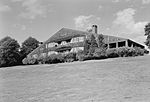Mount Hope Bridge
1929 establishments in Rhode IslandBridges completed in 1929Bridges in Bristol County, Rhode IslandBridges in Newport County, Rhode IslandBuildings and structures in Bristol, Rhode Island ... and 8 more
Buildings and structures in Portsmouth, Rhode IslandFormer toll bridges in Rhode IslandNarragansett BayNational Register of Historic Places in Bristol County, Rhode IslandNational Register of Historic Places in Newport County, Rhode IslandRoad bridges on the National Register of Historic Places in Rhode IslandSuspension bridges in Rhode IslandTowers in Rhode Island

The Mount Hope Bridge is a two-lane suspension bridge spanning the Mount Hope Bay in eastern Rhode Island at one of the narrowest gaps in Narragansett Bay. The bridge connects the Rhode Island towns of Portsmouth and Bristol and is part of Route 114. Its towers are 285 feet (87 m) tall, the length of the main span is 1,200 feet (370 m), and it offers 135 feet (41 m) of clearance over high water. The total length of the bridge is 6,130 feet (1,870 m).
Excerpt from the Wikipedia article Mount Hope Bridge (License: CC BY-SA 3.0, Authors, Images).Mount Hope Bridge
Mount Hope Bridge,
Geographical coordinates (GPS) Address External links Nearby Places Show on map
Geographical coordinates (GPS)
| Latitude | Longitude |
|---|---|
| N 41.639888888889 ° | E -71.258194444444 ° |
Address
Mount Hope Bridge
Mount Hope Bridge
02809
Rhode Island, United States
Open on Google Maps







